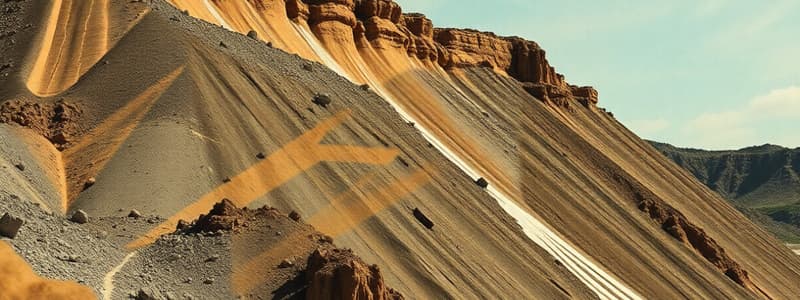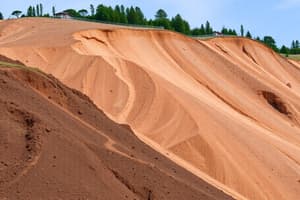Podcast
Questions and Answers
Explain the difference between a landslide and a rockfall. What are the main factors that contribute to each type of mass movement?
Explain the difference between a landslide and a rockfall. What are the main factors that contribute to each type of mass movement?
A landslide is a rapid movement of a large mass of rock, soil, and debris down a slope, typically involving sliding or slumping. A rockfall involves the detachment and freefall of individual rocks from a cliff or steep slope. Landslides are often triggered by factors like heavy rainfall, saturation of soil, seismic activity, or human activities like deforestation or construction. Rockfalls, on the other hand, are primarily caused by weathering, erosion, and the weakening of rock structures due to freeze-thaw cycles, gravity, or seismic events.
Describe the role of vegetation in mitigating the risk of mass movement. How does deforestation contribute to the problem?
Describe the role of vegetation in mitigating the risk of mass movement. How does deforestation contribute to the problem?
Vegetation plays a crucial role in stabilizing slopes and reducing the likelihood of mass movement. The roots of trees and other plants bind soil together, increasing its cohesion and resistance to erosion. Vegetation also intercepts rainfall, reducing the amount of water that infiltrates the ground and potentially triggers landslides. Deforestation removes this protective vegetation cover, leaving slopes exposed and vulnerable to erosion. This reduces soil stability, increases water runoff, and significantly elevates the risk of landslides and other mass movement events.
Explain the concept of 'angle of repose' and its relevance to mass movement. How does this relate to the stability of slopes?
Explain the concept of 'angle of repose' and its relevance to mass movement. How does this relate to the stability of slopes?
The angle of repose is the maximum angle at which a pile of loose material, such as sand or gravel, can rest without collapsing. This angle is determined by the friction between the particles and their size and shape. When the angle of repose is exceeded, the slope becomes unstable and prone to mass movement events like landslides or rockfalls. The stability of a slope is directly related to the angle of repose, as slopes with steeper angles than the angle of repose have a higher risk of failure.
Discuss the role of human activities in triggering mass movement. Provide examples of how human activities can exacerbate the risk of landslides and other mass movement events.
Discuss the role of human activities in triggering mass movement. Provide examples of how human activities can exacerbate the risk of landslides and other mass movement events.
Explain the difference between a creep and a slump. What are the key characteristics that distinguish these two types of mass movement?
Explain the difference between a creep and a slump. What are the key characteristics that distinguish these two types of mass movement?
What are the principal factors that trigger mass movement events?
What are the principal factors that trigger mass movement events?
Describe how water saturation can influence mass movement.
Describe how water saturation can influence mass movement.
Explain the concept of 'angle of repose' and its relevance to mass movement.
Explain the concept of 'angle of repose' and its relevance to mass movement.
How can human activities contribute to the occurrence of mass movement?
How can human activities contribute to the occurrence of mass movement?
What are some strategies used to mitigate mass movement risks?
What are some strategies used to mitigate mass movement risks?
Flashcards
Mass movement
Mass movement
The large-scale movement of soil and rock down a slope due to gravity.
Types of mass movement
Types of mass movement
Includes landslides, mudflows, rockfalls, and slumps.
Causes of mass movement
Causes of mass movement
Gravitational forces, saturation by water, and human activities.
Effects of mass movement
Effects of mass movement
Signup and view all the flashcards
Prevention of mass movement
Prevention of mass movement
Signup and view all the flashcards
Landslides
Landslides
Signup and view all the flashcards
Mudflows
Mudflows
Signup and view all the flashcards
Rockfalls
Rockfalls
Signup and view all the flashcards
Slumps
Slumps
Signup and view all the flashcards
Study Notes
- Mass movement, also known as mass wasting, is the downslope movement of rock, regolith, and soil under the force of gravity.
- It encompasses a wide range of processes, from slow creep to rapid landslides.
- The rate and type of movement are influenced by factors like slope angle, material type, water content, and vegetation.
Types of Mass Movements
- Falls: Sudden, free-falling of rock or debris from a steep slope. Examples include rockfalls and debris avalanches.
- Slides: Movement of a cohesive mass of rock or soil along a well-defined surface, often a plane of weakness. This includes translational slides and rotational slides (slumps).
- Flows: The viscous or fluid-like movement of a mass of material, whether saturated with water or composed of loose debris. This includes debris flows, earth flows, mudflows, and creep.
Factors Affecting Mass Movement
- Slope Angle: Steeper slopes are more prone to mass movement due to increased gravitational pull.
- Material Properties: Type of material (rock strength, soil cohesion, degree of saturation), influences stability and movement style.
- Water Content: Water acts as a lubricant, reducing friction and increasing the weight of the material, thus increasing the likelihood of movement. High water tables near slopes can lead to instability.
- Vegetation: Roots bind soil and regolith, reducing slope instability. Removal of vegetation (deforestation, wildfires) dramatically increases susceptibility.
- Presence of Fractures: Fractures and faults provide planes along which movement can occur. Pre-existing weaknesses are significant factors.
- Earthquake Activity: Earthquakes can dislodge large masses of rock and soil, initiating mass movement events. Seismic activity is a major trigger.
- Human Activity: Construction, excavation, drainage, or changes in land cover can destabilize slopes. Construction projects should account for potential effects on slope stability.
- Geological Structure: Underlying geological structure, including bedding planes, faults, and joints, plays a critical role in slope stability.
Processes of Mass Movement
- Creep: Slow, gradual downslope movement of soil and regolith, often imperceptible.
- Slumps: Rotational movement of a mass of soil along a curved surface. Can involve a distinct rotation and displacement.
- Debris Flows: Rapid flows of water-saturated debris and rocks, often occurring after heavy rainfall or snowmelt. A highly destructive form of mass movement.
- Earthflows: Flows of fine-grained soil that are slower and less turbulent than debris flows. More common in areas of fine-grained sediments.
- Mudflows: Rapid, high-energy flows of mud and debris often associated with volcanic eruptions or intense rainfall. A highly destructive form of mass movement.
- Rockfalls: Rapid freefall of rock fragments down a steep slope. A rapid and high-energy type of mass movement.
Triggering Mechanisms of Mass Movement
- Heavy Rainfall: Saturation of soil increases its weight and lubricates the slope, increasing downslope movement. Increased precipitation is a primary trigger.
- Earthquake Activity: Shaking can dislodge masses of soil and rock, initiating landslides. Seismic activity is a significant trigger.
- Volcanic Eruptions: Pyroclastic flows are highly destructive mass movements associated with volcanic activity. Volcanic activity can initiate mass movements.
- Human-Induced Events: Over-steepened slopes, deforestation, and improper drainage can all destabilize a slope. Human activities are significant contributors to triggering mass movements.
Consequences of Mass Movement
- Loss of Life and Property: Landslides can cause significant damage to infrastructure and endanger human life. Casualties are common.
- Environmental Damage: Landslides can alter drainage patterns, block watercourses, and trigger flooding. This can lead to significant environmental consequences.
- Economic Losses: Damage to infrastructure, agriculture, and property can incur substantial economic losses. The economic damage can be extensive.
- Soil Erosion: Mass movements accelerate the natural erosion of soils. Erosion and loss of fertile land can result.
Mitigation Strategies
- Slope Stabilization: Techniques include retaining walls, terracing, drainage improvements, and the planting of vegetation. Proper engineering solutions are essential.
- Land-Use Planning: Preventing construction in high-risk areas and regulating activities that can destabilize slopes. Careful zoning and planning are essential.
- Monitoring: Using sensors and other technologies to detect and monitor slope stability. Using technology for early detection and monitoring is important.
- Early Warning Systems: Developing systems to provide advance warnings of potential mass movement events. Systems for early warnings will help save lives and property.
Studying That Suits You
Use AI to generate personalized quizzes and flashcards to suit your learning preferences.




